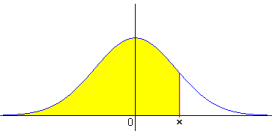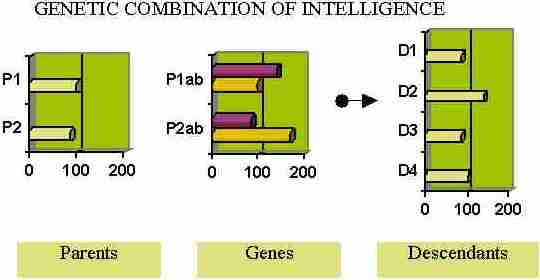4. MENDELIAN GENETICS AND CEL
4.a) Initial Model of intelligence and method LoVeInf
The the basis for the Logical Verification of Information (LoVeInf) that modulates the Mendelian genetic combination is in Title IV of the online book of the Conditional Evolution of Life (CEL)
The statistical model for experimental validation appears in detail in Title VI of the mentioned book.
The following briefly presents the formulation of the model of the heritability of intelligence, based on the Mendelian genetic combination with the corrections provided by the CEL.
The research tries to confirm the LoVeInf method for the potential measured by the intelligence tests.
The proposed model assumes the following hypotheses:
Evolution with external Logical Verification of Information transmitted for the studied capacity.
-
There is a function ξ measuring the different potentials from this capacity.
The IQ refers to the relative position employing a standardized function ξ(I) of the statistical distribution.
This figure shows the generic form of the function ξ (IQ). For an IQ value, it tells the cumulative probability that the population's IQ is equal to or smaller than the same.

The statistical IQ data set includes de variables of Wechsler, Stanford Binet, and Cattel scales that have Normal distribution with a standard deviation of 15, 16, and 24 respectively.
The result of the combination of the four chromosomes in agreement with Mendelian genetics significance will produce four different cases. The mathematical expected value of the capacity of the new individual in accord with the CEL will be the sum of the anticipated averages of each one of the cases pondered by their probabilities.
Method LoVeInf

In the present model of the scientific theory, there are some simplifications to ease its presentation.
Later, it will be necessary to complicate the genetic combination and the LoVeInf method of the Initial Model of the evolution of intelligence to obtain better and impressive estimations, for example, the confirmation of an increase of 10% in IQ for each generation.
4.b) Results of the Initial Model of intelligence
The aim of the empirical research of Mendelian genetics with method LoVeInf and the ordinary least squares is not to obtain the value of the parameters. On the contrary, it is the goodness-of-fit of the estimation, its correlation coefficient (r), and determination coefficient (r²); they represent the relation between the explained variance and the total variance.
Fisher's statistical function F has confirmed that no estimated relationships between the dependent and independent variables of the models are by chance.
The table shows the poor results of the Initial Model of intelligence with Mendelian genetics and method of Logical Verification of Information (LoVeInf)
IQ correlation between father, mother and child

On top of the table, there are the six variables, the three original variables of the children T1 (Stanford Binet scale), T4, WB (Wechsler scale) and the centered variables, T1-d (Stanford Binet scale) corrected with the extreme values, (Wechsler, Stanford Binet test and other test), and X6 (Wechsler, Stanford Binet test and other test).
The other set of variables is made up of the variables proposed by the Conditional Evolution of Life model; parents' variables are functions R, M1F1, (M+F)/2 and M&F; where M1F1 is the vector formed by the smaller values of M or F vectors for each family.The ordinary least squares method gives the M&F correlations with C variables (Wechsler, Stanford Binet test and another test) and with both ancestors simultaneously.
The best result comes when using the variables M and F simultaneously. Nevertheless, it continues being very low and below the range of the generally accepted dependency, which is within 0.35 - 0.80 by previous studies on twins.
A correction due to the degree of kinship between expected and observed correlations for determining the hereditariness degree is not possible since the predicted relationship between parents and children is unknown.
Even if the kinship correction were 50%, the results would continue being very low, although they would be around the indicated inferior level of 0.35
Variations due to the Mendelian inheritance explain these results partially. Additionally, the weak correlations between C children variables themselves mean the incorporation of considerable deviations due to their measurements, the intelligence test used, and the manifestation of the intellectual potential or brainpower due to fatigue.
At this stage, the researchers decided to perform the analysis in groups with the hope that the deviations would compensate and, consequently, improve the model outcome.
